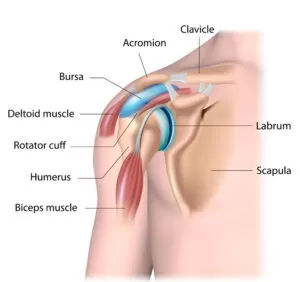
Shoulder Pain
What most people call the shoulder is really several joints that combine with tendons and muscles to allow a wide range of motion in the arm — from scratching your back to throwing the perfect pitch.
Shoulder pain may arise from the shoulder joint itself or from any of the many surrounding muscles, ligaments or tendons. Shoulder pain that comes from the joint usually worsens with activities or movement of your arm or shoulder and may lead to increasing problems with instability or impingement of the soft tissue or bony structures. You may feel pain only when you move your shoulder, or all of the time. The pain may be temporary or it may continue and require medical diagnosis and treatment. Additionally, individuals experiencing shoulder pain may explore the potential benefits of a shoulder pain relief machine to alleviate their discomfort and enhance their overall shoulder health.

Shoulder Pain Symptoms
Shoulder pain is one of the commonest cause of pain in old age. Pain in shoulder can be damage to ligaments, tendons or muscle such as rotator cuff injury or may be caused by frozen shoulder. Such pain restricts the patient to any movement of shoulder joint. CuraLaser alleviates such pain thereby moving the shoulder comfortable around its joint.
The first step in the evaluation is a thorough medical history. Your doctor may ask how and when the pain started, whether it has occurred before and how it was treated, and other questions to help determine both your general health and the possible causes of your shoulder problem. Because most shoulder conditions are aggravated by specific activities, and relieved by specific activities, a medical history can be a valuable tool in finding the source of your pain. Furthermore, your doctor may recommend exploring the potential benefits of a shoulder pain relief machine as part of your treatment plan.
Physical Examination
A comprehensive examination will be required to find the causes of your shoulder pain. Your doctor will look for physical abnormalities, swelling, deformity or muscle weakness, and check for tender areas. He or she will observe your shoulder range of motion and strength.
Tests

Physiotherapy
Physiotherapists are specialists who can help reduce your shoulder pain and show you how to improve the way your shoulder works by using a variety of strengthening and stretching exercise, massage and other therapeutic techniques.
They’ll work with you to improve your symptoms and help get your shoulder moving properly again. What they suggest for you will depend on whether your problem is short-term or a long-standing condition. Almost everyone will benefit from physiotherapy, which may involve the use of a shoulder pain relief machine and various methods such as:
Steroid Injections
The steroid is usually given with a local anaesthetic to ease the pain. You should find your shoulder pain improves quite quickly.
The injection reduces inflammation and allows you to move your shoulder more comfortably. The pain relief should also make your physiotherapy exercises easier. It isn’t usually recommended to have more than two or three injections into your shoulder as this can do more damage to the joint. Some steroid injections may be done with the help of ultrasound imaging. This allows the inflamed tissues to be seen on a monitor and makes sure the injection is given in the correct area.
Surgery
Most shoulder problems improve without surgery. If you do need an operation it can often be performed using keyhole techniques, which require a smaller incision and tend to reduce your recovery time.
Keyhole surgeries include
Conventional open surgery, where a surgeon makes an incision large enough to see the entire damaged area, may sometimes be needed. For example, to repair larger tears in the rotator cuff or for joint replacements. Shoulder replacement is well established and can be very successful, particularly for osteoarthritis and rheumatoid arthritis, when severe pain stops you moving your shoulder properly. There is also a newer type of shoulder operation called a reverse shoulder replacement. In this procedure the ball and socket are reversed. This helps if your rotator cuff tendons have been damaged by arthritis.
Precautions that Prevent from Shoulder Pain
Most people with shoulder pain will recover from their condition. For many there will need to be a commitment to an exercise-based rehabilitation program. It may also be necessary to make modifications to your lifestyle and work practices that aggravate shoulder pain.
Advino CuraLaser is best shoulder pain relief machine and also cures other pains as well. Visit our YouTube channel for a better understanding on how to get the best results with our pain relief laser machine. Please contact our customer care for more help.
References :
https://orthoinfo.aaos.org/en/diseases–conditions/shoulder-pain-and-common-shoulder-problems/
https://www.healthline.com/health/chronic-pain/shoulder-pain#prevention
https://www.versusarthritis.org/about-arthritis/conditions/shoulder-pain/
https://www.mayoclinic.org/symptoms/shoulder-pain/basics/definition/sym-20050696